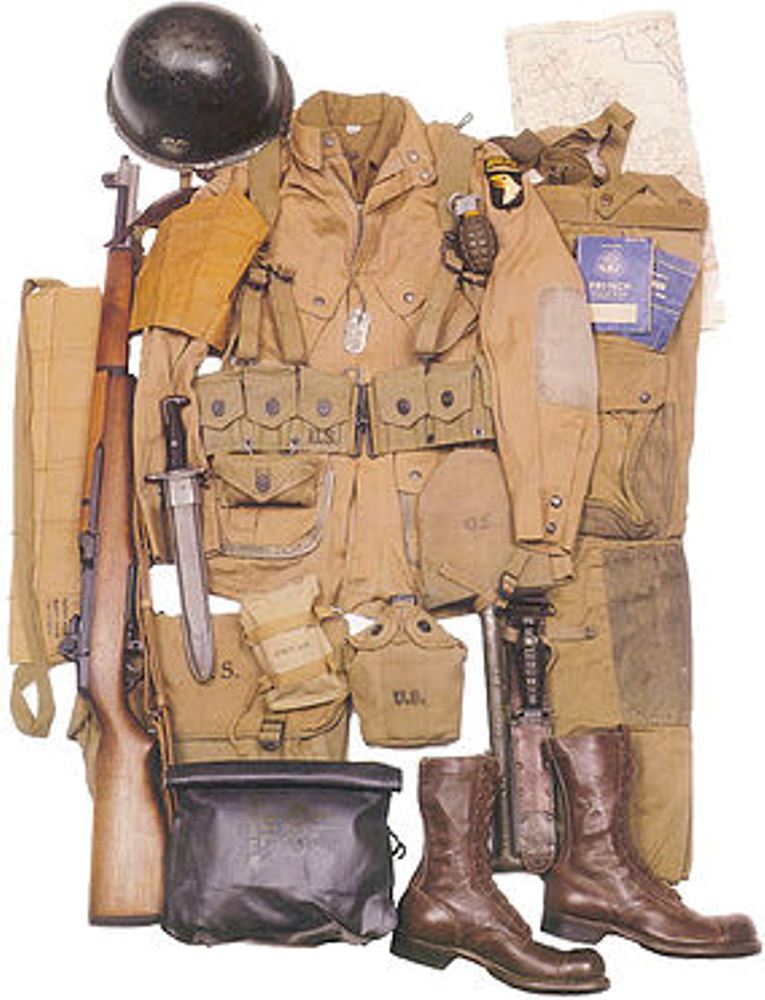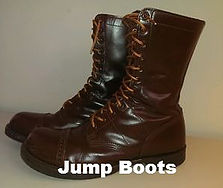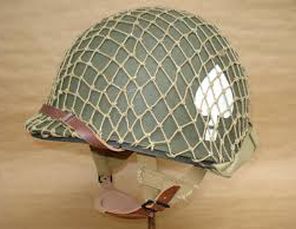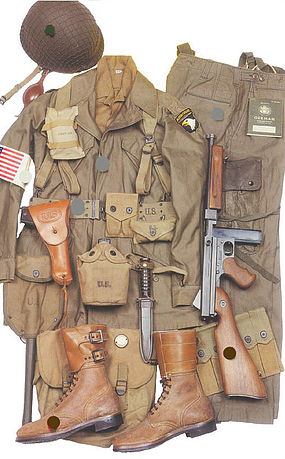Equipment |
|
|
As a new member, knowing what equipment you will need may seem daunting. We are here to help. No new member is expected to have all of the equipment right away. Many of us have been collecting the various parts of our "kit" for many years.We will try to explain the various uniform changes along the way, and inform you of what gear should be procured first, and which items are secondary. Understand that the 101st Airborne (ABN) went through various periods where the issued equipment was different than the last period. When the 101st's companies were formed at Camp Toccoa (formerly Camp Toombs) in 1942 and all of the future paratroopers were issued a standard set of gear. As time progressed different gear was issued as changes in the Airborne, and the Army, were occurring constantly. Your first order of business as a newly minted Airborne re-enactor is to get your basic military items. These include the items in List #1 below and are considered "US Army Standard Issue" which was issued to all Army enlisted personnel. |
|
Period #1: Equipment assigned at Toccoa (Boot Camp) through transport to the ETO.Clothing & Equipage Allowances Period #2: Fitted for ETO transport to the ETO
Period #3: D-Day (Mission Albany);
Period #4: Market-Garden Campaign
Period #5: Battle of the Bulge (Bastogne); and finally
Period #6: Post-Bastogne to the end of the war |
|
The following information is intended to remind our old members, and inform our new members, of the equipment need depending on which type of event we are attending. Essentially there are five main periods of time, in which we depict primarily three periods.
- Period #1: is the assigned equipment from Boot Camp through transport to the ETO.
- Period #2: Fitted for ETO transport to the ETO through D-Day;
- Period #3: Market Garden Campaign,
- Period #4: Battle of the Bulge (Bastogne); and finally
- Period #5: Post-Bastogne to the end of the war
PERIOD #1: Boot Camp (Standard Issue) |
|||||||||||||||||||||||||||||||||||||||||||||||
| 6 pr underwear, white (boxers or briefs) | |||||||||||||||||||||||||||||||||||||||||||||||
| 6 pr T-Shirts (white or OD green, Tank or T-shirt) | |||||||||||||||||||||||||||||||||||||||||||||||
| 6 pr Socks, Wool, OD Green | |||||||||||||||||||||||||||||||||||||||||||||||
| Mess Kit | |||||||||||||||||||||||||||||||||||||||||||||||
PERIOD #2: Transport from NY through ETO Training |
|||||||||||||||||||||||||||||||||||||||||||||||
Perios #3: D-Day / Normandy (Operation Neptune) |
|||||||||||||||||||||||||||||||||||||||||||||||
06 June 1944 - 29 June 1944
|
IN VARIOUS POCKETS 1ea Drawers, Wool Field Bag (Musette Bag or 1928 Haversack) Raincoat Sulfanilimide Powder Gas Mask |
||||||||||||||||||||||||||||||||||||||||||||||
Operation Market - Garden |
|||||||||||||||||||||||||||||||||||||||||||||||
17 September 1944 - 27 November 1944
|
|||||||||||||||||||||||||||||||||||||||||||||||
Battle of the Bulge |
|||||||||||||||||||||||||||||||||||||||||||||||
19 December 1944 - 25 January 1945 |
|||||||||||||||||||||||||||||||||||||||||||||||
| STANDARD EQUIPMENT CARRIED BY EACH PARACHUTIST 1. The following equipment will be carried by all parachutists. 1 Belt, pistol or rifle, dismounted 1 Boots, parachutist, pair 1 Canteen, cup and cover...on belt 1 Compass, lensatic or watch...on belt 1 Cap, wool knit 1 Drawers, wool 1 Field bag...Under parachute harness 1 Gloves, horsehide unlined, pair 4 Grenades, hand, frag. MkII...2 Waist pockets coat...2 hip pockets trousers 1 Handkerchief...Left chest pocket 1 Helmet, steel, M1, mod. (I think), w/liner 1 Knife, pocket, M2...Center chest pocket 1 Knife, trench, M3, w/scabbard M6...on belt 1 Matches, package 1 Mask, gas (If required) 1 Message book, pencil and maps...Right chest pocket 1 Parachute, T-5, complete 1 Pouch, first-aid and packet...on belt 2 Ration "K" (broken down)...Leg pockets 1 Raincoat...Loop over belt 1 Rope, parachutist, 30' x 3/8"...Looped on belt 1 Prophylaxis, mechanical, kit...Right chest pocket 2 Socks, light wool, pair...1 pair in field bag 1 Spoon, M/26...In canteen cover 1 Supporter, athletic (optional) Tablets, chlorine or halazone...Left chest pocket Tablets, bentadine (?)...Right chest pocket 2 Tags, identification, w/necklace 2 Tape, ankle (optional) Tissue, toilet...Left chest pocket 1 Toilet set...Waist pockets 1 Tool, entrenching...On belt 1 Undershirt, wool 1 Uniform, parachutists, 2-pc. 2. Following additional equipment will be carried by Officers: 1 Binoculars, M-13...Over shoulder or on belt 1 Carbine, cal..30, M1A1 (except field Off)...On belt in scabbard 1 Case, canvas, dispatch...Over right shoulder 1 Flashlight, TL-122-A...Left leg pocket 1 Map, template M2...Dispatch case 1 Pistol, auto., cal..45 (Field O's. only)...On belt in holster 1 Pocket, double web.w/clips (Field O. only)...On belt 2 Pocket, mag., carbine, cal..30, M1A1 (except field Officers)...On belt Whistle, thunderer...Left chest pocket |
|||||||||||||||||||||||||||||||||||||||||||||||
Uniform ReferenceUniform ReferenceWe have had customers requesting information about what the US Army soldiers and US Marines wore during WWII. We wrote this page to answer some of those questions. Listed below are tables showing basic (non-specialized) descriptions of uniforms and equipment, along with our itemized prices for those reproductions. Customers are advised to seek ensemble packages for uniforms listed on other pages in this website. Please let us know if you wish us to expand this list.
Just as a point of trivia, the following was cited from The Quartermaster Review May-June 1945, "Data compiled for millions of inductees shows the following to be the actual measurements of the "average" newcomer to the Army as he appears at the clothing counter of a reception center: 5' 8" tall; 144 pounds in weight; 33 ¼" chest measurement; 31" waist measurement. From the tariff tables showing the frequency of size issues it is found that the sizes most frequently issued are a 7 to 7½ hat, number 9 gloves, a 15 shirt with a 33" sleeve, a 36 regular jacket, a pair of trousers with a 32" waist and a 32" leg length, size 11 socks, and size 9-D shoes. These figures may be taken to indicate the size of the "average American young man." |
|||||||||||||||||||||||||||||||||||||||||||||||
UNIFORMS & EQUIPMENTPersonal EquipmentThe primary impression of the 101st is that of an Airborne trooper in WWII. However, we have an optional 327th Glider impression available for those who are working on assembling their airborne impression or for those who wish to portray another integral part of an Airborne Division, the Glider Infantry Regiment. There exist three levels of uniform and equipment requirements, and a fourth optional level. The fourth level, while not required, will complete the impression satisfactorily, and is recommended for those who are exceptionally serious about their impression. Levels One, Two, and Three must be verified by an Officer, the Quartermaster and one witness at the yearly Soldier School in order to qualify for completion of the Level. All clothing and equipment must be kept serviceable. All shirts, jackets and coats are required to have Division insignia on left shoulder and rank insignia on both arms if applicable. Level 1: D-Day Impression Combat Clothing (Airborne) Coat, Parachute Jumper, M1942* *M42 Jump Jacket should have 101st ABN patch on left shoulder, early style dog chain preferred, NO 48 star flag. Combat Clothing (Glider) Coat, Field, M1941 *M41 Jacket should have 101st ABN patch on left shoulder. Field Equipment Helmet, Steel, M1C or M2 w/liner (khaki webbing) and leather chin cup* (Airborne) *Helmet should have 502nd PIR ID (2" Heart on both sides, with "click" to right of heart) for Airborne and 327th GlR ID (2" club on both sides, with "click" to the --- of club) for Glider. Weapons Related Knife, Fighting, M3 w/ M8 or M6 Scabbard ONE OF THE FOLLOWING (select based on weapon carried) Belt, Cartridge, M1923, khaki Upon completing Level One, members are awarded the airborne cap badge or glider cap badge and are able to participate in the rank structure. Level 2: Operation Market Garden to Berlin Combat Clothing Jacket, Field, M1943 Winter Clothing (Bulge & Later) Cap, Wool Knit, M1941 ("jeep cap") Miscellaneous Field Gear Can , Meat (mess kit), M1910, M1918, M1932 or M1942 Upon completion of Level Two, the member receives the Regimental Oval and automatically receives the rank of Private First Class in accordance with Article II. Level 3: Class A Impression Coat, Wool Serge, 4-Pocket (Preferred), OR Jacket, Field, M1944 Upon completion of Level Three, the member receives the Parachutist Badge (jump wings) or Glider Badge to be worn on the dress uniform only. Unless other rank is held, the member is also assigned the rank of Corporal in accordance with Article II. Level 4 (not required, but will complete the impression) Watch, Hack or Ordnance Again, Level Four Requirements are not mandatory. However, it is hoped that members will take into consideration that this equipment will create an accurate Airborne / Glider impression, and will strive to obtain as many items listed herein as possible. Approved Weapons Individual Served: U.S. Rifle, Caliber .30, M1, (Garand) *First Rifle to acquire and carry is the M1 Garand. This is the PRIMARY Weapon. **Pistol does not count toward Level One Weapon Requirement. ***M1C and M1D Sniper rifles are not approved for use as they entered the ETO during Occupation, not before V-E Day. Crew Served: Machine Gun, Caliber .30, Light, Air Cooled, M1919A4 OR M1919A6 **Recoiless Rifles are not approved for use as they entered the ETO in late March 1945 and first saw combat at the end of April 1945 with the 17th ABN. Bayonets: For U.S. Rifle, Caliber .30, M1 (Garand Only) Bayonet, M1905, 16" |
|||||||||||||||||||||||||||||||||||||||||||||||
Individual Item Descriptions & Buying Guide |
|||||||||||||||||||||||||||||||||||||||||||||||
| Coat, Parachute Jumper, M1942 | |||||||||||||||||||||||||||||||||||||||||||||||
| Trousers, Parachute Jumper, M1942 | |||||||||||||||||||||||||||||||||||||||||||||||
| Cap, Garrison, OD Serge Wool or Khaki Cotton | In February 1941 a new cap, based upon the World War I overseas cap, was standardized, eliminating the issue of the service cap. The service cap remained an optional item authorized for purchase and wear. The new cap came in both olive drab wool serge and khaki cotton to match the service uniforms. In June 1942, the specifications for the cap were modified slightly so that the body of the cap was slightly higher in the back. Upon becoming branch qualified, each soldier was required to add appropriate branch colored piping to the edge of the side curtain of the cap. Since Fox Co. was airborne infantry, the correct color is light blue. | ||||||||||||||||||||||||||||||||||||||||||||||
| Helmet, M1 and M1C |
After extensive research and development in 1940 and 1941, the Ordnance Department in cooperation with the Infantry Board and private industry developed a new steel helmet. The body of the helmet was standardized in June 1941 as the M1. It was made from a single piece of Hadfield Manganese steel with a stainless steel rim butted and spot welded in front. Spot welded to each side was a fixed stainless steel wire chinstrap loop. The helmet was painted inside and out with an olive drab paint mixed with a cork aggregate, and two-piece khaki web chinstrap was stitch to the loops. Because the paint did not adhere well to the stainless steel rim, it was changed to Manganese in 1944, and the butt of the rim moved to the back of the helmet. The M1 helmet was designed to have a separate liner with a white rayon suspension system similar to that used in football helmets of the time. The initial liner was made of two fiber shells glued together and covered with varnished cloth. Use of the liners in the field quickly showed that they absorbed moisture and lost strength and durability. In July 1941, the Quartermaster Department began the process of finding a suitable plastic Helmet, Steel, M1 liner for the M1 helmet. In February 1942, a molded, resin impregnated cloth helmet lined was adopted and contracts let for immediate production. The new liner had a suspension consisting of three loops of herringbone twill cotton tape riveted to the sides and tied together with a cord in the center. A leather and cloth headband was clipped to the suspension and could be sized adjusted with a buckle. There was also an olive drab cotton neck band that snapped into the back of the suspension, and a russet leather chinstrap that attached to an interior stud on each side towards the front. |
||||||||||||||||||||||||||||||||||||||||||||||
| Uniform, Herringbone Cotton Twill |
In May 1941 it was announced that the blue denim fatigue uniform would be phased out and replaced with an olive drab, herringbone cotton twill (HBT) uniform. The new uniform was single breasted with five black metal tack buttons in front, plus a waist band with two additional buttons. The jacket also had a notched lapel with a fall collar, and two patch-type breast pockets with a split pleat in the center and a flap secured by a single metal tack button. The uniform was intended for both a fatigue and field use. In November 1942, and improved version was released. Based on field experience, the breast pockets were made larger with a bellows gusset on the outer edge, and the waist band was eliminated. Treated with an anti-vesicant compound, HBTs were also used as chemical protective garments, particularly during the Invasion of France in June 1944. In March 1943, a specification change was made, changing the color of HBTs to a darker Olive Drab Shade 7. Either a hat or cap of the same olive drab herringbone twill cotton material could be worn with the HBT uniform. The hat was generally worn for fatigue while the cap was intended for wear as a work cap by mechanics and others performing similar duties, but it also became popular as a combat field cap used by troops serving in the Pacific Theater. |
||||||||||||||||||||||||||||||||||||||||||||||





